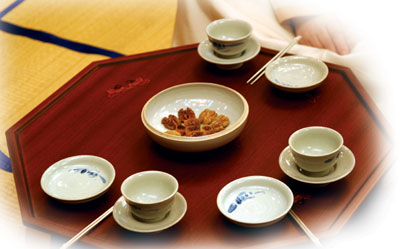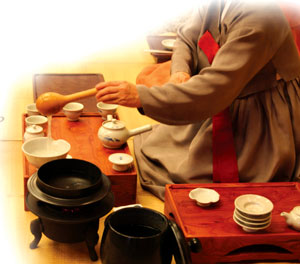Dado, the traditional process of making and drinking tea
 | ||
Dado refers to the whole process of making tea. Generally, it starts with picking and infusing tea leaves, followed by boiling them, straining the liquid, and finally serving it in a cup and offering it to another person. There are various kinds of dado, depending on to whom the tea is served, and their processes differ slightly.
There is a misconception that dado is originally a Japanese custom, but this tradition started in China in the 8th century and then spread into Korea and Japan. China and Japan's dado have unique characteristics in terms of ideology. In Japan's hwakyung, based ideology, dado pursues peace and accord. To pursue harmony with all things including nature, animals and human beings, it adheres strict, polite rules and emphasizes formality. Meanwhile, China's dado is based on kumduk ideology. It pursues frugal, good-natured characteristic and tries to make tea into a sublime art form.
In Korea, the origination of dado can be found in the Shilla Dynasty, used for the education of chivalry. Korean traditional dado was improved and used in the nobles' culture in the Goryeo Dynasty and in temple culture during the Joseon Dynasty. Throughout the Joseon era, dado was almost abolished because of the restraints of Buddhism, but during the 19th century, thanks to the monk Cho-hee who wrote "Dongasong," a book on dado, it was re-absorbed into the common people's culture and has ever since been revised and improved. "Korean dado's ideology can be classified as joongjung ideology, which pursuits moderation. With it, ancestors tried to overcome the desire for fame and riches," explains Park Kwon-hum, Chairman of The Tea Union.
 | ||
| ▲ Photographed by Lee Yang-jung | ||
"By learning dado, we can achieve mental maturity and stability. It teaches us that nothing should be either extravagant or lacking. This is the grand attraction of Korean dado," says Woo Jae-joon (Soph., Dept. of Computer Science), the president of Kwan-Sul-Cha-Hoe. As he says, Korean dado deserves to be preserved due to its beneficial instructions for the modern world on how to lead a composed and harmonious life. The most important aspects of dado are not in its process but in having a tranquil and balanced mental state. The overall appeal of tranquility in this chaotic modern world helps this ancient Eastern tradition maintain its relevance.
| Recommended Traditional Tea - Nok-cha |
Goo Ja-gun Cub Reporter
nottinghilllove@yonsei.ac.kr

